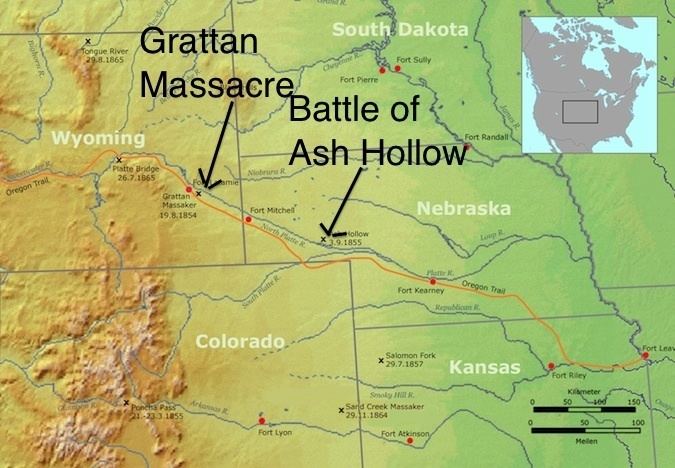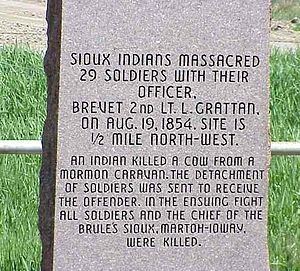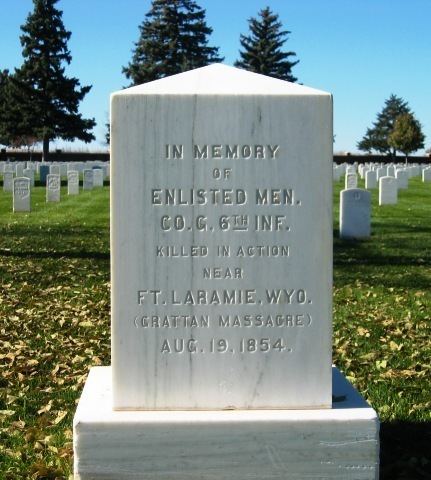2 killed All 31 killed | Date 19 August 1854 | |
 | ||
~1,200 warriors 30 Soldiers1 Civilian interpreter Similar Battle of Ash Hollow, American Indian Wars, Battle of Mud Springs, Sioux Wars, Battle of Warbonnet Creek | ||
The Grattan Massacre, also known as the Grattan Fight, was the opening engagement of the First Sioux War, fought between United States Army and Lakota Sioux warriors on August 19, 1854. It occurred east of Fort Laramie, Nebraska Territory, in present-day Goshen County, Wyoming.
Contents

A small detachment of soldiers entered a large Sioux encampment to arrest a man accused of taking a migrant's cow, although such matters by treaty were to be handled by the US Indian Agent. After one of the soldiers shot Chief Conquering Bear and killed him, the Brulé Lakotas returned fire and killed a total of 29 soldiers, Lieutenant John Grattan, and a civilian interpreter. The massacre, as it was called by the American press, is considered an early, significant event in the Plains Indian Wars.

Background

In the late summer of 1854, about 4,000 Brulé and Oglala were camped near Fort Laramie in accordance with the terms of the Treaty of 1851. On August 17, a cow belonging to a Mormon traveling on the nearby Oregon Trail strayed and was killed by a visiting Miniconjou named High Forehead. Lt. Hugh Fleming, the senior officer of the small garrison, consulted with the chief, Conquering Bear, to discuss the loss of livestock. Lt. Fleming was evidently unaware, or chose to ignore, that such matters were, by the terms of the Treaty of 1851, to be handled by the local Indian Agent, in this case John Whitfield, who was due to arrive within days with annuities with which restitution could be made.

Aware that the matter did not really concern the military, Conquering Bear attempted to negotiate, offering a horse from his personal herd or a cow from the tribe's herd. The cow's owner persisted in demanding $25 instead. Lt. Fleming asked the Sioux to arrest High Forehead and deliver him to the fort, which Conquering Bear refused; he had no authority over the Miniconjou and did not want to violate their tradition of hospitality. The day's talk ended in stalemate.
Second Lieutenant John Lawrence Grattan, of the U.S. 6th Infantry Regiment, a recent graduate of West Point and supernumerary waiting for a vacancy in the regiment, led an armed detachment into the Indian encampment to take custody of High Forehead and bring him back to the fort. Grattan was inexperienced and contemptuous of the Lakotas' ability as warriors. This was his first encounter with the Sioux. A commander at Laramie later recalled, "There is no doubt that Lt. Grattan left this post with a desire to have a fight with the Indians, and that he had determined to take the man at all hazards." In Grattan's party were a sergeant, a corporal, 27 privates and a French-Native American interpreter named Lucienne Auguste; the military forces had two artillery pieces in addition to arms.
Circumstances
By the time the detachment reached the encampment, Auguste was intoxicated from drinking along the way, as he feared the encounter. Grattan broke his bottle and scolded him. Auguste was not well liked by the Sioux; he spoke only broken Dakota, and had little grasp of other dialects. As they entered the encampment, he began to taunt the Sioux, calling their warriors women, and saying the soldiers were not there to talk, but to kill them all. James Bordeau, who owned the nearby trading post and observed the encounter, later told of it.
Historians estimate the encampment had some 1,200 warriors out of the total 4,800 population. According to Bordeau, Lt. Grattan began to realize the risk, and stopped to discuss the situation with the trader. Bordeau advised him to talk directly with Conquering Bear and let him handle the situation. Grattan seemed to understand and continued on into the encampment. Going first to the lodge of High Forehead, he ordered him to surrender to the US forces. High Forehead said he would die first.
Grattan went to Conquering Bear, saying the Sioux should arrest the guilty party and turn him over. Conquering Bear refused but tried to negotiate, offering a horse as compensation for the cow. Bordeau reportedly said the interpreter Auguste taunted the Sioux, and failed to fully or accurately translate Conquering Bear and Grattan's comments, as there seemed to be confusion between them. Conquering Bear asked that the trader Bordeau act as interpreter, as the Sioux trusted him and his language ability. Called by the Sioux, Bordeau rode to the meeting place; later he said he could see the situation was out of hand. As Grattan pressed Conquering Bear, numerous Sioux warriors moved into flanking positions around the soldiers. Bordeau returned to the trading post, where he told associates to get arms, as a fight was coming.
Ending the discussion, Grattan began walking back to his column. A nervous soldier fired his gun, shooting a Sioux. The warriors started shooting arrows while leaders tried to take control. Conquering Bear was mortally wounded and died nine days later near the Niobrara River. The Sioux warriors quickly killed Grattan, 11 of his men, and the interpreter. A group of some 18 soldiers retreated on foot trying to reach some rocks for defense, but they were cut off and killed by warriors led by Red Cloud, who was then a rising War chief within the Sioux. One soldier survived the massacre but later died of his wounds. The 28 killed soldiers are buried at Fort McPherson, Nebraska, while Lt. Grattan is buried in Fort Leavenworth, Kansas.
Conquering Bear was the only Lakota who was killed. Bordeau was spared both because he was married to a Brulé Sioux woman, and he had a friendly relationship with the tribes.
Aftermath
The enraged warriors "rampaged throughout the night, swearing to attack other whites." They rode against Fort Laramie the next morning but withdrew; they looted the trading post but did not harm Bourdeau. On the third day after the US attack, the Brule and Oglala abandoned the camp on the North Platte River and returned to their respective hunting grounds. On the fourth day, the military asked Bourdeau to arrange a burial party. His team went to the scene and found that the slain soldiers had been ritually mutilated. Grattan’s body was identified by his watch and was returned to the post for burial. The remains of the troops were interred at the site in the same shallow grave.
The soldiers' remains were later exhumed and re-interred at Fort McPherson National Cemetery, where a white marble monument was erected in their memory. Grattan's remains were moved later to Fort Leavenworth National Cemetery in Kansas. A historical marker was later erected about one-half mile from the site of the events (see photo above.)
The U.S. press called the event the "Grattan Massacre." Accounts generally ignored the US soldiers' instigation of the event by shooting Conquering Bear in the back, and Grattan's violation of the treaty provisions. When news of the fight reached the War Department, officials started planning retaliation to punish the Sioux. Secretary of War Jefferson Davis characterized the incident as "the result of a deliberately formed plan."
Col. William S. Harney was recalled from Paris in April 1855 and sent to Fort Kearny, where he assembled a command of 600 troops consisting of troops from the 6th Infantry, 10th Infantry, 4th Artillery, and his own 2nd US Dragoons. In all he had four mounted companies led by Lt. Col. Philip St. George Cooke and five companies of infantry under Major Albemarle Cady. They set out on August 24, 1855 to find and exact retribution on the Sioux. Harney was quoted as saying, "By God, I'm for battle—no peace."
Warned by Thomas S. Twiss of the Indian Bureau that the army had put a force in the field, half of the Lakota camped north of the Platte came into Fort Laramie to be treated as friendly. The other half, generally led by Conquering Bear's successor Little Thunder, remained at large, considering themselves peaceful but aware of Harney's approach and continuing to harbor warriors sought by the army. Harney engaged them in the Battle of Ash Hollow (also known as the Battle of Bluewater Creek) on September 3, 1855, in which U.S. soldiers killed a number of Brulé Sioux in present-day Garden County, Nebraska. The village of 230 persons was caught between an assault by the infantry and a blocking force by the cavalry.
Harney returned to Fort Laramie with 70 prisoners. On October 25 the three warriors sought by the expedition surrendered themselves, were held for a year at Fort Leavenworth, then released. Harney ordered the tribes to send representatives to a treaty council at Fort Pierre in March 1856, where a treaty was signed on terms dictated by the War Department. However Twiss tried to undermine the treaty and Harney had him removed from office without possessing the legal authority to do so. Commissioner of Indian Affairs George W. Manypenny then successfully lobbied the Senate to reject the treaty and Twiss was reinstated. Nevertheless, the specter of Harney restrained the Lakota for nearly ten years.
Historians such as Griske believe the following nearly quarter-century of intermittent warfare on the Great Plains was triggered by the Grattan massacre. Others suggest numerous factors, especially US desire for control of lands that were Sioux territory, as to make warfare inevitable.
